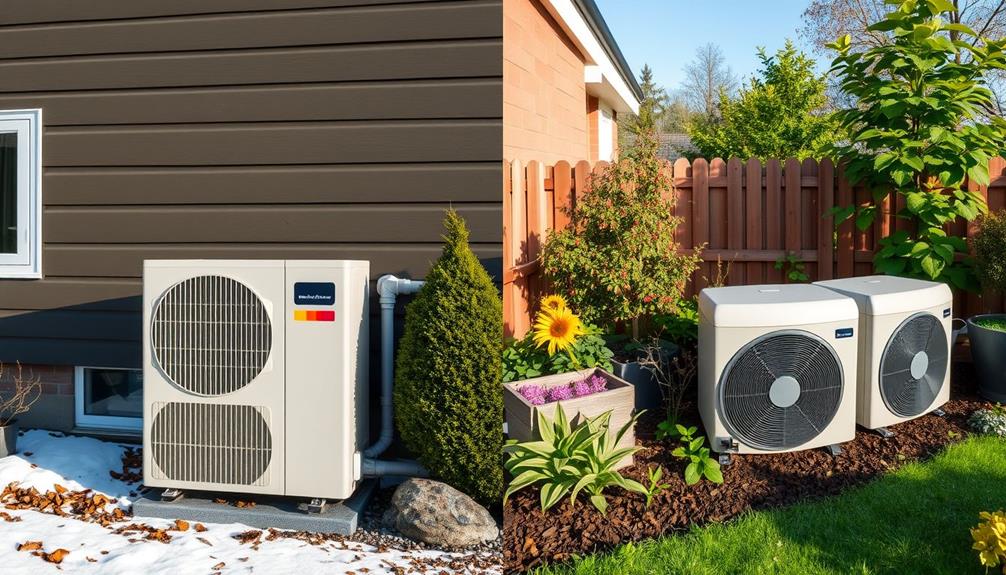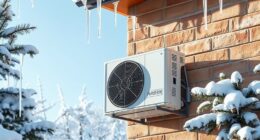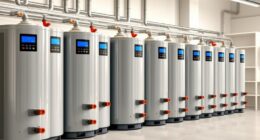When considering air-source versus ground-source heat pumps, you'll find pros and cons for each. Air-source heat pumps are typically more affordable to install and easier to set up. However, they tend to be less efficient in colder climates. On the other hand, ground-source heat pumps require higher initial costs due to complex installation but offer superior efficiency and longevity in harsh weather. They also boast better environmental benefits. Balancing the upfront costs, operational efficiency, and environmental impact will help you make a more informed choice. To find out which option suits you best, keep exploring the details.
Key Takeaways
- Cost of Installation: Air Source Heat Pumps (ASHPs) are typically cheaper to install, averaging around £14,000, while Ground Source Heat Pumps (GSHPs) start at £20,000.
- Energy Efficiency: GSHPs are more energy-efficient, offering a Seasonal Performance Factor (SPF) of 4 compared to ASHPs' SPF of 2.8.
- Performance in Cold Weather: GSHPs maintain higher performance in cold temperatures, achieving a Coefficient of Performance (COP) of 2.94, while ASHPs drop to 1.0.
- Long-term Savings: GSHPs can save approximately £16,475.20 over 20 years in energy costs, despite higher initial installation expenses.
- Environmental Impact: GSHPs can reduce CO2 emissions by up to 80%, while ASHPs achieve around a 20% reduction, contributing to environmental sustainability.
Understanding Heat Pumps
When it comes to heating and cooling your home, understanding heat pumps is fundamental. Heat pumps work by transferring heat from one location to another, making them an efficient option for your heating system.
There are two main types: Air Source Heat Pumps (ASHP) and Ground Source Heat Pumps (GSHP). ASHPs extract heat from the ambient air, while GSHPs leverage stable underground temperatures.
Both systems utilize thermal energy transfer basics to enhance efficiency, with refrigerants playing an important role in absorbing and releasing heat.
Regarding installation costs, ASHPs are generally less expensive, costing around £14,000. However, GSHPs, starting at £20,000, offer higher energy efficiency and lower operational costs in the long run.
When the temperatures drop, GSHPs maintain a higher Coefficient of Performance (COP)—around 2.94 at 0°F—compared to ASHPs, which can drop to a COP of just 1.0 under the same conditions.
The lifespan of these systems also varies; GSHPs typically last over 20 years, with ground loop components lasting more than 50 years, while ASHPs usually last around 15 years.
Both types greatly reduce carbon emissions, with GSHPs cutting emissions by up to 80% and ASHPs achieving a reduction of about 20%.
Understanding these differences will help you make an informed decision.
Comparison of Efficiency
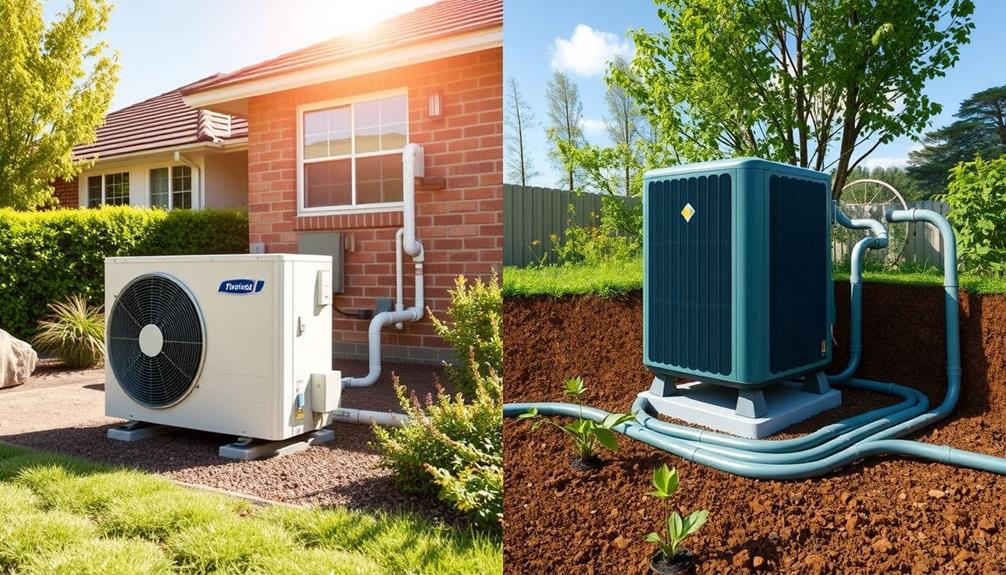
In the domain of heating efficiency, Ground Source Heat Pumps (GSHP) stand out as a superior option compared to Air Source Heat Pumps (ASHP). With a Seasonal Performance Factor (SPF) of 4, GSHPs can produce four units of heat for every unit of electricity consumed. In contrast, ASHPs typically have an SPF of around 2.8, making them less energy efficient.
Furthermore, utilizing effective home comfort solutions can further enhance your heating strategies. When temperatures drop, GSHPs continue to perform well, achieving a Coefficient of Performance (COP) of 2.94 at 0°F, while ASHPs' efficiency plummets to a COP of just 1.0. This means that in cold weather, GSHPs require 3.6 times less electricity than ASHPs, highlighting their efficiency advantage in colder climates.
Additionally, when you consider operational costs, GSHPs deliver heating at approximately 6.8p per kWh, compared to ASHPs at around 9.8p per kWh. Over time, this cost difference becomes significant, reinforcing the advantages of ground-source heat pumps.
Installation and Cost Analysis
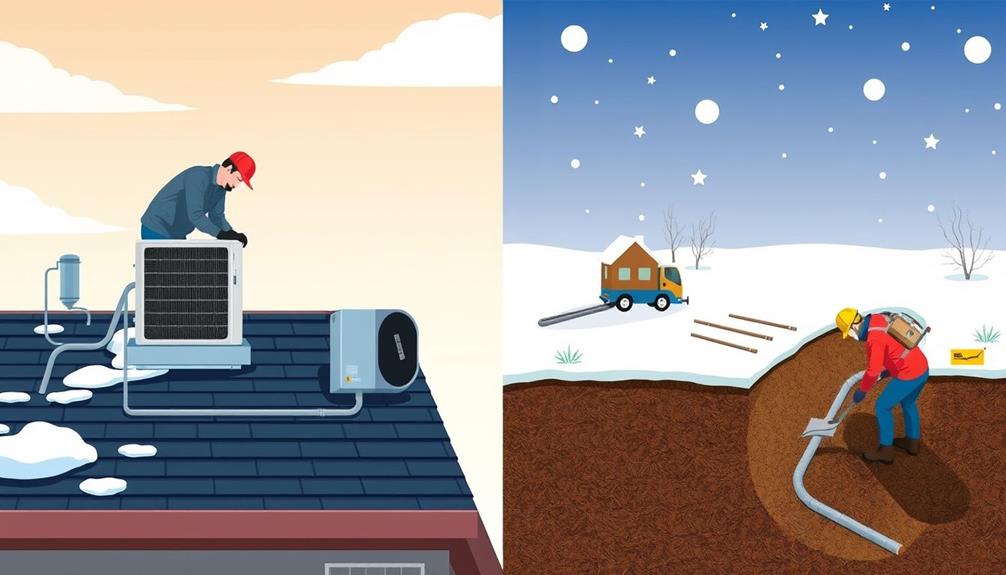
When considering installation and costs, you'll find key differences between air-source and ground-source heat pumps.
Air-source systems usually have lower upfront costs and simpler installations, while ground-source systems can be more complex and expensive.
Additionally, it's important to evaluate essential home cleaning kit items to guarantee your space is well-maintained during the installation process.
However, the long-term savings from ground-source heat pumps may offset those initial expenses, making it vital to weigh your options carefully.
Installation Complexity Comparison
Installation complexity plays an essential role in choosing between air-source heat pumps (ASHPs) and ground-source heat pumps (GSHPs). Generally, ASHPs offer a simpler installation process, usually completed in just a few days with minimal disruption. In contrast, GSHPs require considerable site preparation, which can involve drilling and creating trenches, often taking weeks to finish.
| Heat Pump Type | Installation Complexity |
|---|---|
| Air-Source (ASHP) | Lower; quick setup in days |
| Ground-Source (GSHP) | Higher; requires extensive site prep and drilling |
GSHPs need outdoor space for installation, which can be a limiting factor for some homeowners. Their installation depth varies considerably, ranging from 4-6 feet for horizontal systems to 100-400 feet for vertical ones. This invasiveness can disrupt your landscaping and requires careful planning.
While ASHPs typically have lower installation costs and complexity, GSHPs might provide long-term efficiency benefits that can justify their higher initial challenges and expenses. Ultimately, understanding these factors helps you make a more informed decision that aligns with your needs and property constraints.
Upfront Cost Differences
Choosing between air-source heat pumps (ASHPs) and ground-source heat pumps (GSHPs) often hinges on upfront costs. Generally, ASHPs have lower installation costs, averaging around £14,000, compared to GSHPs, which start at approximately £20,000 and can go up to £45,000 for larger homes.
This price difference is due to the more complex installation of GSHPs, which require underground piping that increases labor costs and installation time. Additionally, considering various investment strategies, such as a Gold IRA, can be beneficial for funding your energy efficiency upgrades.
While GSHPs have higher upfront costs, they can provide significant energy savings over time. For instance, over 20 years, GSHPs can save you about £16,475.20 in energy expenses. In contrast, ASHPs typically cost around £9.8 per kWh of heat to operate, while GSHPs are more economical at about £6.8 per kWh.
Both systems might qualify for federal tax credits and utility incentives, potentially reducing those upfront costs, particularly for GSHP installations. Ultimately, when weighing upfront costs, consider not just the initial investment but also the long-term benefits and savings each system offers.
Long-term Savings Potential
There's a significant difference in long-term savings potential between air-source heat pumps (ASHPs) and ground-source heat pumps (GSHPs) due to their varying efficiencies and operational costs.
While ASHPs are more affordable upfront, typically costing around £14,000, GSHPs have higher installation costs, ranging from £20,000 to £30,000. However, over a 20-year period, GSHPs can yield estimated energy savings of £16,475.20, thanks to their superior energy efficiency.
Additionally, as with air purifiers, regular maintenance of heat pumps can enhance their performance and longevity, which is essential for maximizing savings proper usage of air purifiers.
In terms of payback period, GSHP installations usually break even within 5 to 10 years due to their lower annual operating costs compared to ASHPs. GSHPs are also 2-4 times more energy efficient than traditional systems, making them a more attractive choice in the long run, especially in extreme weather conditions.
Although ASHPs offer some energy savings, their efficiency drops in colder climates, impacting your long-term savings.
Both systems can benefit from federal tax credits and utility incentives, further enhancing their long-term savings potential.
Ultimately, when considering installation costs and energy efficiency, GSHPs may provide more significant returns over time, despite their higher initial investment.
Environmental Considerations
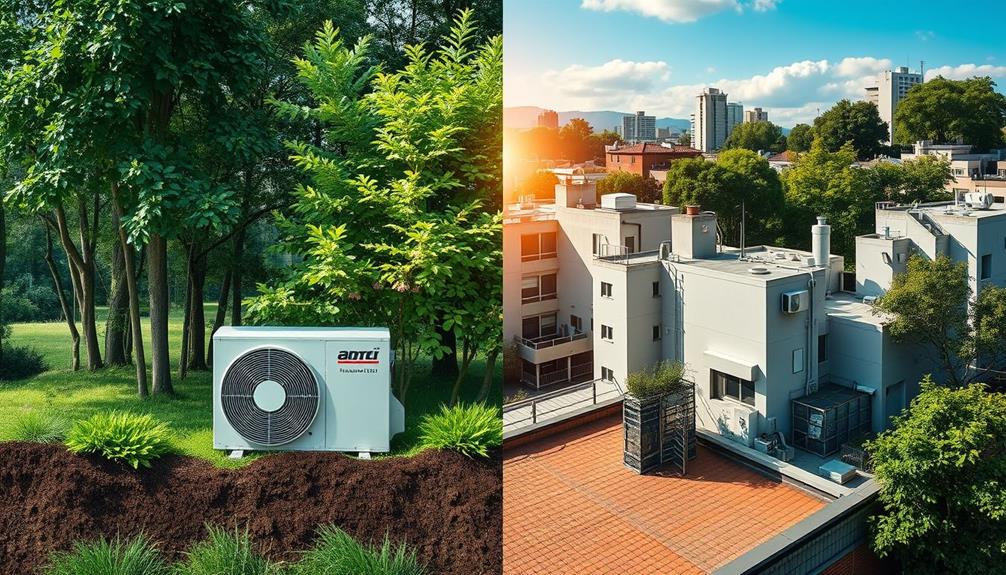
When considering environmental impacts, you'll find that both air-source and ground-source heat pumps greatly reduce carbon emissions compared to traditional systems.
Ground-source heat pumps can cut CO2 emissions by up to 80%, while air-source options achieve reductions of around 20%.
Additionally, these systems harness renewable energy, and their efficiency can be further enhanced by understanding geothermal energy generation practices.
However, it's important to weigh the potential land disturbance caused by their installation.
Carbon Emission Reduction
While both ground-source heat pumps (GSHP) and air-source heat pumps (ASHP) offer considerable advantages for carbon emission reduction, GSHP technology stands out with the potential to cut CO2 emissions by up to 80%. This makes GSHPs markedly more effective in lowering your carbon footprint compared to ASHPs, which can only reduce emissions by up to 20%.
By adopting GSHP technology, you could experience a reduction in greenhouse gas emissions by 50-70% compared to conventional heating systems. Additionally, utilizing renewable energy sources, such as those found in gout management insights, can further enhance sustainability efforts.
One of the key benefits of GSHPs is their reliance on renewable energy from the Earth's stable temperatures. This reduces your dependence on fossil fuels, which contribute heavily to carbon emissions.
Since space heating, cooling, and water heating account for about 70% of home energy use, moving to heat pumps can play a major role in decreasing overall carbon emissions in residential energy consumption.
However, it's crucial to keep in mind that the widespread use of both GSHPs and ASHPs may increase demands on the energy grid, potentially necessitating more renewable energy sources to meet these growing energy needs sustainably.
Renewable Energy Utilization
The shift towards renewable energy utilization is a vital aspect of enhancing the environmental benefits of both ground-source heat pumps (GSHP) and air-source heat pumps (ASHP). GSHPs leverage the Earth's stable underground temperature, allowing them to reduce CO2 emissions by up to 80%. This greatly lowers your carbon footprint compared to traditional heating systems.
Additionally, implementing advanced security measures for energy systems can help protect against potential cyber threats that may impact efficiency and reliability, as seen in cybersecurity challenges. On the other hand, ASHPs achieve reductions of up to 20%, making them a viable option for those making the change to renewable energy.
By utilizing renewable energy resources, GSHPs not only promote sustainability but also minimize energy consumption. Since heating, cooling, and water heating account for about 70% of home energy use, heat pumps represent a considerable opportunity to cut back on fossil fuel reliance.
The installation of GSHPs can help lower greenhouse gas emissions by 50-70%, aligning with global climate goals.
However, as you consider adopting these heat pumps, keep in mind that widespread usage may increase demand on the grid. It's important to plan carefully and integrate renewable energy sources to manage this demand sustainably, ensuring that the change supports both your energy needs and environmental objectives.
Land Disturbance Impact
Land disturbance is an essential factor to take into account when choosing between ground-source heat pumps (GSHP) and air-source heat pumps (ASHP). GSHPs require significant excavation for underground pipes, which can disrupt local ecosystems during installation. This land disturbance can be considerable, especially if large trenches or boreholes are needed.
In contrast, ASHPs typically have minimal site impact, allowing for a more straightforward installation process that preserves the surrounding environment. Additionally, the implementation of AI security in environmental assessments can streamline the regulatory process, ensuring compliance with various standards while minimizing disruption to the land, promoting AI-driven threat intelligence.
While GSHPs might cause initial disruption, they often result in less surface-level disturbance post-installation since they don't have external units, maintaining a low visual impact on the landscape.
Additionally, because environmental assessments are often required for GSHP installations, you may face more regulatory hurdles compared to installing ASHPs.
Both systems contribute positively to reducing carbon emissions, but GSHPs may offer a slight edge in environmental impact due to their reduced operational footprint after installation.
Ultimately, if minimizing land disturbance is a priority for you, ASHPs might be the better choice, but GSHPs could provide long-term benefits worth considering.
Maintenance and Durability
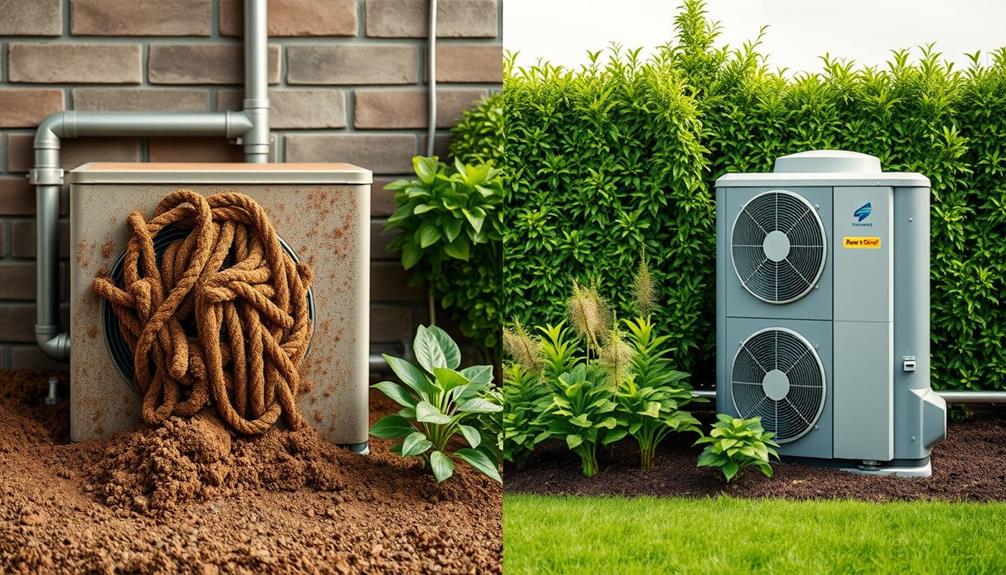
When deciding between air-source heat pumps (ASHP) and ground-source heat pumps (GSHP), maintenance and durability play essential roles.
ASHPs typically have a lifespan of around 15 years and require more frequent maintenance due to their exposure to outdoor elements. Effective treatment for outdoor exposure, similar to strategies for reducing hospital visits, will guarantee peak performance. You'll need to change filters every 3-6 months to guarantee peak performance.
In contrast, GSHPs can last over 20 years, with their underground components exceeding 50 years and offering a low-maintenance operation.
The durability of GSHPs is enhanced by their installation below ground, protecting them from weather-related wear and tear.
ASHPs, however, face challenges like corrosion and mechanical issues from outdoor exposure, which can lead to more operational issues, especially in extreme cold. This often necessitates maintenance checks to maintain efficiency.
Making an Informed Choice
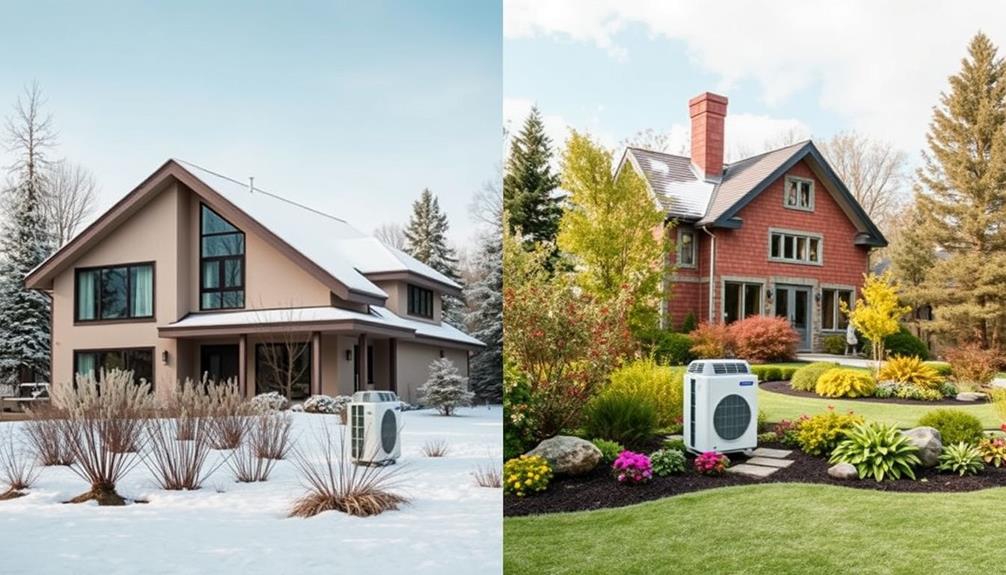
Choosing between air-source and ground-source heat pumps involves weighing several important factors, including installation costs, efficiency, and maintenance needs.
If you're on a tight budget, air-source heat pumps (ASHP) are typically the more affordable option, with installation costs around £14,000. However, ground-source heat pumps (GSHP) can offer better energy efficiency, especially in colder climates, where they maintain a higher coefficient of performance (COP) compared to ASHPs.
Consider your local climate when making your informed choice. GSHPs excel in extreme cold, making them more suitable for areas that experience harsh winters. While their upfront installation costs start at £20,000, the long-term savings can be significant—around £16,475.20 over 20 years due to their efficiency.
Maintenance requirements also play a role in your decision. GSHPs generally require less upkeep and boast a longer lifespan of over 20 years, while ASHPs last around 15 years and need more frequent maintenance.
Additionally, don't forget to explore local incentives and federal tax credits, which can help offset the initial costs, making GSHPs a compelling long-term investment.
Frequently Asked Questions
Which Is Better, a Ground Source Heat Pump or an Air Source Heat Pump?
When choosing between a ground source heat pump and an air source heat pump, consider your budget, installation space, and long-term savings. Each has its strengths, but your specific needs will determine the better option.
What Are the Downsides of a Ground Source Heat Pump?
Imagine digging a deep hole in your backyard; that's what installing a ground source heat pump feels like. You'll face high costs, complex installation, and potential maintenance headaches if things go wrong underground. It's not easy!
What Are the Disadvantages of an Air Source Heat Pump?
Air source heat pumps can struggle in extreme winter temperatures, leading to reduced efficiency. They also require regular maintenance and may produce noise, which could disturb your peace and potentially annoy neighbors. Consider these factors carefully.
Which Is Better, a Heat Pump or Geothermal?
If you want the ultimate energy solution, geothermal heat pumps are the champions. They offer unmatched efficiency and longevity, making them a smart investment. You'll save more on energy bills while enjoying a greener home.
Conclusion
In choosing between air-source and ground-source heat pumps, you're weighing efficiency against installation costs, and environmental benefits against maintenance needs. While air-source systems are easier and cheaper to install, ground-source options offer superior efficiency and longevity. Ultimately, your decision hinges on your priorities—whether you value upfront savings or long-term performance. By considering these factors, you can find the heat pump that best fits your lifestyle, making your home both comfortable and energy-efficient.
